Reflections on 2018
For the Michigan Department of Natural Resources, 2018 has been busy. The DNR, with the help of many partners, has made great strides in its ongoing efforts to take care of the state’s natural and cultural resources and provide outstanding outdoor recreation opportunities.
Here are a few highlights of how the DNR spent 2018.
Providing quality outdoor recreation opportunities
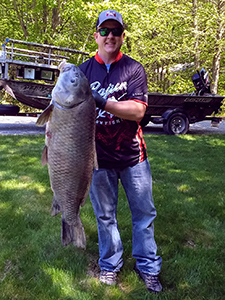 The DNR continued its work to ensure excellent opportunities for hunting and fishing, both of which contribute billions of dollars to the state’s economy each year.
Fourteen state-record fish have been caught in Michigan in the last 10 years, pointing to the abundance and health of our fish populations.
The DNR stocks more than 25 million fish each year, in more than 1,000 locations across both peninsulas. Forty percent of all recreational fishing in Michigan depends on stocked fish.
In 2018, the DNR expanded the recently created Fishing Tournament Information System – a statewide, online registration and reporting tool that makes it easier for tournament managers to meet the requirement of having all bass fishing tournaments registered – to include all bass and walleye tournaments. To date, the system has received more than 2,000 bass tournament registrations and results reports.
The DNR is continually improving habitat on the 4.5 million acres of public hunting land it manages. Hunters can explore seven managed waterfowl areas, 19 grouse enhanced management sites (known as GEMS) that allow walk-in hunting, and more than 180 state game and wildlife areas. These locations also offer abundant wildlife watching opportunities.
|
 So far this year, hunters have contributed almost $200,000 to wildlife management by purchasing Pure Michigan Hunt applications that give them a shot at a prize package valued at over $4,000, as well as licenses for elk, bear, spring and fall turkey and antlerless deer, and first pick at a managed waterfowl area. The application period ends at midnight Dec. 31.
Michigan’s 103 state parks continue to provide the scenic spaces, natural resources and access to outdoor recreation opportunities that attract tens of millions of people every year.
With 12,500-plus miles of state-designated trails and pathways – one of the largest, interconnected trail systems in the country – Michigan is known as The Trails State. This trails system offers plenty of social, economic and health benefits, catering to a variety of users, including bicyclists, hikers, ORV riders, cross-country skiers, snowmobilers, horseback riders, paddlers and others.
|
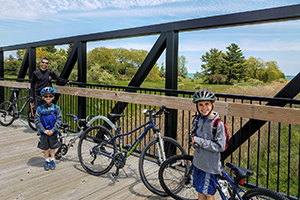 The system also includes the Iron Belle Trail, Michigan’s signature hiking and biking trail extending more than 2,000 miles from the far western tip of the Upper Peninsula to Belle Isle in Detroit.
There was renewed interest sparked in 2018 in the Iron Belle Trail Fund Campaign, marked by an event in Ann Arbor where more than $10.5 million in private donations was announced.
“Quality outdoor recreation resources and opportunities mean a lot to the people who use and value them, and to the communities they serve,” DNR Director Keith Creagh said. “The Iron Belle Trail offers so many beautiful places where people make memories, improve their health, and recharge their energy. The state and our many partners are on an ambitious timeline to get the remainder of these connected miles in place.”
To date, the DNR and partners have built and engineered more than 100 miles of new trail to complete completed the Iron Belle Trail’s 1,422 miles of existing hiking and biking trails, with just over 600 remaining to be connected.
In October 2018, the Ralph C. Wilson Jr. Foundation announced a $100 million investment of parks and trails in Southeast Michigan, including segments of the Iron Belle Trail.
|
 With the creation of a new State Water Trails program, the DNR announced this month that eight waterways, totaling 540-plus miles flowing through more than a dozen counties, have been selected as the first state-designated water trails in Michigan.
DNR Parks and Recreation Chief Ron Olson said that water trails are an increasing trend in Michigan and nationally, as interest in paddle sports and other water-based recreation continues to grow.
Water trails feature well-developed access points, often are near significant historical, environmental or cultural points of interest and often have nearby amenities like restaurants, hotels and campgrounds.
“These state-designated water trails will encourage close-to-home outdoor recreation and healthy lifestyles while boosting local economies, giving even more reason to call Michigan The Trails State,” said Paul Yauk, the DNR’s state trails coordinator.
The DNR’s staffed shooting ranges, located in southern Michigan state parks and game areas, made improvements to accommodate a growing number of shooting sports enthusiasts. Updates this year included expanding parking, adding new handgun shooting stations and installing a well to provide potable water, with construction of new accessible parking and walkways planned at three ranges in 2019.
Looking to get outdoors in 2019? Check out michigan.gov/dnrcalendar.
Taking care of Michigan’s woods, waters and wildlife
The “Good Neighbor Authority” allows state natural resource agencies to assist the U.S. Forest Service and the federal Bureau of Land Management on timber and watershed restoration projects across the country.
In 2018, the DNR increased its Good Neighbor Authority efforts from the previous year, preparing 2,400 acres for timber sale and producing 38,500 cords of wood from the four national forests in Michigan – the Huron and Manistee national forests in the Lower Peninsula and the Ottawa and Hiawatha in the Upper Peninsula.
This state/federal partnership will grow to more than 7,500 acres in 2019.
|
 In 2018, oversight of the state’s Registered Forester program transferred to the DNR from the Michigan Department of Licensing and Regulatory Affairs. The move was part of a restructuring process for this voluntary program that encourages higher standards for Michigan’s foresters.
Changes to the program include an up-to-date online database and a new complaint review process.
“The new program is the ideal source for landowners to find highly qualified foresters to help them manage their forest land,” said Deb Begalle, chief of the DNR’s Forest Resources Division.
Nearly two-thirds of Michigan’s 20 million acres of forest are privately owned; the state manages an estimated 4 million acres of public forest.
The DNR also manages 360,000 acres of state game areas. At game areas throughout Michigan, DNR staffers have been harvesting timber to create early successional forest habitat.
|
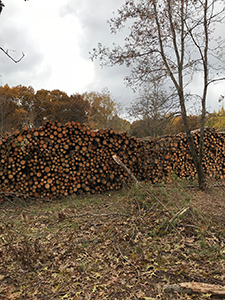 The selective cutting of mature pine and aspen stands encourages the growth of young forests, which provide vital habitat for ruffed grouse, American woodcock, deer, elk and golden-winged warblers.
“This important work may look destructive while in progress, but the result is outstanding habitat for many game and non-game wildlife species,” said DNR Wildlife Division Chief Russ Mason.
Late in 2018, in partnership with Pheasants Forever and the Hal and Jean Glassen Foundation, the DNR launched its new Adopt-A-Game-Area program, which encourages individuals and organizations to sponsor grassland habitat projects on state-managed lands they use and value.
“Grasslands give important benefits to both wildlife and people. In addition to providing habitat and food resources for many wildlife species, grasslands also improve water and air quality,” said Al Stewart, DNR upland game bird specialist.
Stewart said grassland pollinators, like bees and monarch butterflies, help to generate crops that keep the country fed. Throughout Michigan, many grasslands are being converted to agriculture and development. Grasslands now are one of the rarest habitat types in the world.
Expanded support of this program, through sponsorships, will provide valuable nesting, brood-rearing, foraging and winter habitat for a wide range of wildlife, including deer, turkeys, pheasants, ducks, rabbits, songbirds and pollinators.
|
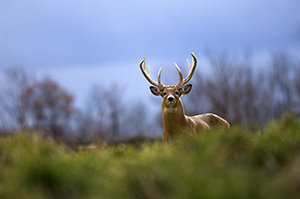 This year, the DNR has been intensely focused on mitigating impacts from chronic wasting disease on Michigan’s white-tailed deer population. This fatal disease has been found in free-ranging deer in Clinton, Dickinson, Eaton, Gratiot, Ingham, Ionia, Jackson, Kent, and Montcalm counties.
Following public engagement meetings and surveys, hunting regulations were changed for the 2018 deer hunting seasons to address concerns of CWD. The DNR also provided additional staffed deer check locations as well as drop boxes for hunters to submit their harvested deer for testing. More than 30,000 deer were checked and tested this year.
The coming year will see continued efforts to maintain the health of Michigan’s deer herd. For the latest information and updates on chronic wasting disease, visit michigan.gov/cwd.
The DNR also keeps a close eye on the health of Michigan’s fish, working continuously with Michigan State University’s Aquatic Animal Health Lab to be at forefront of disease identification, but also regularly analyzing groups of wild fish to test for diseases and performing fish health inspections at state hatcheries and on hatchery-reared fish.
In 2018, the DNR’s Office of the Great Lakes completed restoration of historical environmental impacts on the Menominee River, started the Saginaw Bay Fish Reef restoration project and made strides in implementing goals established in the Michigan Water Strategy.
The OGL staff also worked in communities to protect coastal resources, helped establish an alliance of Great Lakes island communities and facilitated the development of shared harbor visions in waterfront communities.
As it has each year since its introduction in 2014, the Invasive Species Grant Program – implemented by the Michigan departments of Agriculture and Rural Development, Environmental Quality and Natural Resources – provided roughly $3.6 million in 2018 for projects designed to prevent, detect, eradicate and control invasive pests on the land and in the water.
Because of this grant program, more than 285,000 acres of land and water have been surveyed for invasive species; more than 18,000 acres have been treated for invasive terrestrial and aquatic plants; and millions of people have been reached with educational information about invasive species.
“It’s clear that Michigan’s Invasive Species Grant Program is accomplishing many of the goals set for the program at the very start,” said Creagh. “The fight to stop, contain and eradicate invasive species from Michigan’s woods and water is critical to the long-term protection of these valuable natural resources, and this grant program is helping in that fight.”
Protecting the state’s natural resources and citizens
|
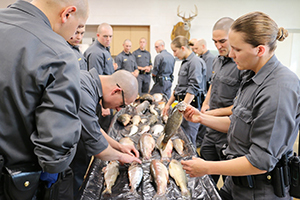 Located in every county of the state, Michigan conservation officers are first responders who provide lifesaving operations in the communities they serve. They are fully commissioned state peace officers who provide natural resources protection, ensure recreational safety and protect citizens by enforcing Michigan’s laws and regulations.
“A conservation officer has chosen to not only protect our people and local communities as first responders – they have devoted their career to being front-line defenders of our natural resources,” said DNR Law Enforcement Division Chief Gary Hagler.
As community first responders, several conservation officers were involved in lifesaving actions during 2018, including saving a woman from drowning, rescuing people involved in snowmobile and kayak accidents and those stranded in Lake Huron and on the edge of a cliff overlooking Lake Superior. As a result, eight conservation officers received the Michigan DNR Lifesaving Award.
The DNR Conservation Officer Academy graduated 24 new conservation officers in 2018. The new officers were selected from nearly 500 applicants to be a part of Recruit School No. 9 – the DNR’s 23-week training academy based in Lansing.
“Our division selects the most highly qualified candidates to receive additional training that no other law enforcement agency in the state offers,” Hagler said. “Our officers are molded into quality people who are embedded within the communities they serve.”
As Michigan’s oldest statewide law enforcement agency, the DNR Law Enforcement Division continues to expand its abilities to protect our natural resources. The 252 officers budgeted for the 2019 fiscal year is an all-time high.
Connecting people with the outdoors
Since the beginning of the 2018-2019 school year, over 1,000 educators have received the DNR’s free wildlife curricula for their classrooms, information that helps give students an understanding of Michigan’s wildlife and their habitats. Kindergarten through high school educators can get these resources for use in the second half of the school year. Featured species include waterfowl, black bears and elk.
|
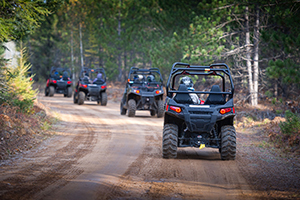 The DNR recently – after two years of mapping and reviewing the condition of the state forest roads it maintains across both peninsulas – completed an initial inventory used to create interactive maps showing where ORV use is allowed on these roads. The maps will be available online at michigan.gov/forestroads and updated each spring.
Look for an early 2019 “Showcasing the DNR” story detailing the efforts to map state forest roads, a resource to help people get out and enjoy Michigan’s public forests.
The DNR’s work in providing GIS products and services gained national recognition at the annual Esri User Conference, when the department earned a Special Achievement in GIS Award for its innovative application of mapping, data analytics and thought leadership.
“Within the past 20 years, the DNR has implemented an enterprise GIS system to support the growing needs and challenges of caring for Michigan’s natural resources and connecting the public to those resources,” said Dave Forstat, DNR GIS manager and chief data steward.
“As web GIS has become more prevalent, we’ve leveraged the benefits of increased communication and data accuracy to provide customers with the best possible data on trails, water, minerals, trees, wildlife, fish and other areas.”
This includes online tools – like the Open Data Portal, interactive maps, story maps and customized apps – aimed at connecting outdoor enthusiasts and natural resources professionals with the information they need.
This is just a brief glimpse of a year in the life of the DNR. More information about the department’s broad range of work to ensure healthy natural resources and outdoor recreation is available on the DNR website, redesigned in 2018 to make it easier to use, at michigan.gov/dnr.
|
Check out previous Showcasing the DNR stories in our archive at michigan.gov/dnrstories. To subscribe to upcoming Showcasing articles, sign up for free email delivery at michigan.gov/dnr.
/Note to editors: Contact: John Pepin, Showcasing the DNR series editor, 906-226-1352. Accompanying photos and a text-only version of this story are available below for download. Caption information follows. Credit Michigan Department of Natural Resources, unless otherwise noted.
Text-only version of this story
Academy: The DNR Conservation Officer Academy graduated 24 new conservation officers in 2018. Here, recruits – in their 12th of 23 weeks of training – learn how to properly identify all of Michigan’s fish species.
Deer and Deer 2: In 2018, the DNR has been intensely focused on mitigating impacts from chronic wasting disease on Michigan’s white-tailed deer population.
Forester: A Michigan DNR forester in the western Upper Peninsula marks a boundary for a future timber sale in Iron County. In 2018, Michigan's Registered Forester program moved to the DNR.
Hunt: Previous Pure Michigan Hunt Winner Jim Bosscher of McBain, Michigan, on opening day of waterfowl season at Fish Point State Game Area in Tuscola County. So far this year, hunters have contributed almost $200,000 to wildlife management by purchasing Pure Michigan Hunt applications.
Iron Belle: The Iron Belle Trail provides bike riders and hikers with many scenic views, like from this bridge in Tawas near Alabaster.
Kayak: Eight waterways, totaling 540-plus miles flowing through more than a dozen counties, have been selected as the first state-designated water trails in Michigan.
Maps: Combining the technology of GIS with the science of geography, the DNR is able to offer a variety of tools – Open Data Portal, maps, apps and others – to help outdoor enthusiasts and natural resources managers find the information they most want and need.
ORVs: The DNR recently – after two years of mapping and reviewing the condition of the state forest roads it maintains across both peninsulas – completed an initial inventory used to create interactive maps showing where ORV use is allowed on these roads.
Record: Brandonn Kramer poses with his state record black buffalo, taken while bowfishing on the Grand River in Ottawa County this past May. Fourteen state-record fish have been caught in Michigan in the last 10 years, pointing to the abundance and health of our fish populations.
Timber: At state game areas throughout Michigan, DNR staffers have been harvesting timber to create early successional forest habitat. The selective cutting of mature pine and aspen stands encourages the growth of young forests, which provide vital habitat for ruffed grouse, American woodcock, deer, elk and golden-winged warblers./
|